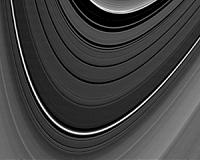 |
Pasadena CA (JPL) Nov 05, 2010 Engineers at NASA's Jet Propulsion Laboratory, Pasadena, Calif., are working to understand what caused NASA's Cassini spacecraft to put itself into "safe mode," a precautionary standby mode. Cassini entered safe mode around 4 p.m. PDT (7 p.m. EDT) on Tuesday, Nov. 2. Since going into safe mode, the spacecraft has performed as expected, suspending the flow of science data and sending back only data about engineering and spacecraft health. Cassini is programmed to put itself into safe mode automatically any time it detects a condition on the spacecraft that requires action from mission controllers on the ground. Engineers say it is not likely that Cassini will be able to resume full operations before a planned Nov. 11 flyby of Saturn's moon Titan. But Cassini has 53 more Titan flybys planned in its extended mission, which lasts until 2017. "The spacecraft responded exactly as it should have, and I fully expect that we will get Cassini back up and running with no problems," said Bob Mitchell, Cassini program manager based at JPL. "Over the more than six years we have been at Saturn, this is only the second safing event. So considering the complexity of demands we have made on Cassini, the spacecraft has performed exceptionally well for us." Since Cassini launched in 1997, Cassini has put itself into safe mode a total of six times. The Cassini-Huygens mission is a cooperative project of NASA, the European Space Agency and the Italian Space Agency. The Jet Propulsion Laboratory, a division of the California Institute of Technology in Pasadena, manages the mission for NASA's Science Mission Directorate, Washington.
Share This Article With Planet Earth
Related Links Explore The Ring World of Saturn and her moons Jupiter and its Moons The million outer planets of a star called Sol News Flash at Mercury
 Cassini Sees Saturn Rings Oscillate Like Mini-Galaxy
Cassini Sees Saturn Rings Oscillate Like Mini-GalaxyPasadena CA (JPL) Nov 02, 2010 Scientists believe they finally understand why one of the most dynamic regions in Saturn's rings has such an irregular and varying shape, thanks to images captured by NASA's Cassini spacecraft. And the answer, published online in the Astronomical Journal, is this: The rings are behaving like a miniature version of our own Milky Way galaxy. This new insight, garnered from images of Saturn's ... read more |
|
| The content herein, unless otherwise known to be public domain, are Copyright 1995-2010 - SpaceDaily. AFP and UPI Wire Stories are copyright Agence France-Presse and United Press International. ESA Portal Reports are copyright European Space Agency. All NASA sourced material is public domain. Additional copyrights may apply in whole or part to other bona fide parties. Advertising does not imply endorsement,agreement or approval of any opinions, statements or information provided by SpaceDaily on any Web page published or hosted by SpaceDaily. Privacy Statement |